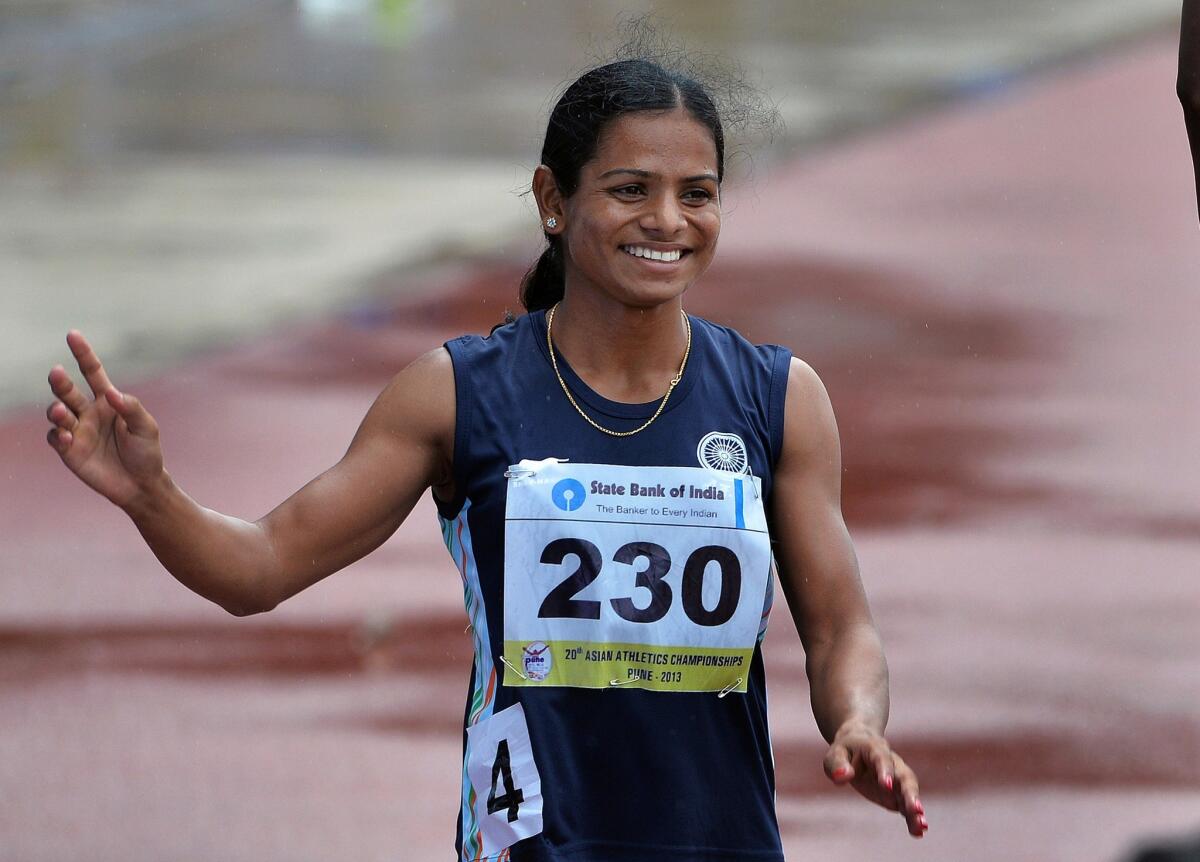Op-Ed: Should female athletes have to prove they are women?

Indian athlete Dutee Chand waves to the crowd after completing a race in India in 2013.
- Share via
Indian sprinter Dutee Chand recently secured the right to compete as a woman, even though her natural level of testosterone may exceed international track and field regulations for female athletes. Missing from news reports on Chand’s “win” at the international Court of Arbitration for Sport is one key fact: The ruling has left Chand and others like her vulnerable because it specifies that, given new scientific evidence, the court might yet accept some biological marker as a legitimate means to determine which women can and cannot play.
Put otherwise, the court might yet decide it’s in the business of adjudicating who’s really a woman and who’s not.
International sports authorities have over the years changed which biological marker they think should divide female and male athletes. For a while it was genitals, then sex chromosomes. Most recently they’ve settled on testosterone levels.
In pop culture, testosterone gets called a “male hormone.” In fact, all women and men make it naturally. Most men make more than most women. But some women, like Chand, are born with intersex body types that push their naturally occurring testosterone level into the male-typical range.
The International Olympic Committee and the International Assn. of Athletics Federation argue that testosterone matters enough to sports performance that some intersex women should be stopped from competing as women, unless they submit to medical interventions that will squash their testosterone levels. They tried to do that with Chand.
The IOC and the IAAF claim this is just about biology and sports and not personal identity. They say they’re just preventing women from playing if they have a “male typical” inborn advantage. But the fact is that the decisions of the IOC and the IAAF end up either enforcing or challenging cultural gender norms, and it’s easy to see why some might understand their verdicts as the equivalent of a gender test.
Indeed, Chand’s own national sporting authority, the Athletics Federation of India, has admitted that it pursued a sex diagnosis for Chand “so as to avoid any embarrassment to India in the international arena at a later stage.”
During hearings, Chand pleaded with the court to understand how much her life depended on its decision. According to the court’s report: “She described how a young female friend had been forced to leave her village after people refused to accept her as a girl because of her physical appearance.... She fears that if she loses her appeal, she will have to leave her [own] village.”
Chand’s fear is not unfounded. Female athletes who have been subjected to this kind of scrutiny have historically experienced significant psychological harm and social backlash. One of the former athletes testifying to the court, Maria Jose Martínez-Patiño, spoke of her painful experience in 1986, when sports authorities dismissed her from the Spanish Olympic team because they discovered she had been born with a Y chromosome and testes.
Chand and her defenders have argued that hers is a perfectly fair natural advantage, akin to any other, like greater height, bigger hands or better oxygen-processing capability. The IAAF disagrees, seeing “hyperandrogenism” (high levels of testosterone) as a natural but unfair advantage for intersex female athletes.
The IAAF claimed to the court that hyperandrogen conditions show up at a rate of only 1 in 20,000 women in the general population but at a rate of 142 in 20,000 elite female athletes. This, they insisted, proves how much of an edge these hormones give.
But the court was unpersuaded by the IAAF’s data. “The panel,” it explained, “is not satisfied that the degree of that [testosterone] advantage is more significant than the advantage derived from the numerous other variables which the parties acknowledge also affect female athletic performance: for example, nutrition, access to specialist training facilities and coaching, and other genetic and biological variations.”
Nevertheless, the court concluded that the IOC and the IAAF might someday produce science that will convince the court that testosterone or some other biological marker should divide women’s sport from men’s. Intersex women, then, might yet be subject to biological decisions about their identities as female athletes, even though they were born and raised as girls, and even though the biological variations they have occur along a natural spectrum.
As long as the IOC and the IAAF try to find the gender dividing line in biology, some athletes born and raised female are going to be subject to problematic questions about their identities. If the IAAF, the IOC and now this court really believe what they keep telling people — that their policies aren’t supposed to be a “gender verification test” — then they’re going to have to give up searching for a persuasive biological dividing line and conclude that what makes you a woman is just being in the world as a woman.
Alice Dreger is professor of clinical medical humanities and bioethics at Northwestern University’s Feinberg School of Medicine. She is the author most recently of “Galileo’s Middle Finger: Heretics, Activists, and the Search for Justice in Science.”
Follow the Opinion section on Twitter @latimesopinion and Facebook
More to Read
A cure for the common opinion
Get thought-provoking perspectives with our weekly newsletter.
You may occasionally receive promotional content from the Los Angeles Times.










